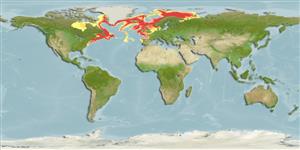Elasmobranchii (sharks and rays) >
Squaliformes (Bramble, sleeper and dogfish sharks) >
Somniosidae (Sleeper sharks)
Etymology: Somniosus: Latin, somnus = sleep (Ref. 45335).
Environment / Climate / Range
Ecology
Marine; brackish; benthopelagic; depth range 0 - 2200 m (Ref. 247), usually 200 - 600 m (Ref. 35388). Deep-water; 1°C - 12°C (Ref. 247), preferred 6°C (Ref. 107945); 83°N - 35°N, 95°W - 61°E
Arctic and North Atlantic.
Length at first maturity / Size / Weight / Age
Maturity: Lm ?, range 244 - 427 cm
Max length : 730 cm TL male/unsexed; (Ref. 247); max. published weight: 775.0 kg (Ref. 4699); max. reported age: 392 years (Ref. 110949)
Dorsal
spines
(total): 0;
Dorsal
soft rays
(total): 0;
Anal
spines: 0;
Anal
soft rays: 0;
Vertebrae: 41 - 44. A gigantic, heavily-bodied dogfish shark with a moderately long, rounded snout and small, low dorsal fins; lower caudal lobe long; upper jaw with small single-cusped teeth and lower jaw with moderate-sized, bent-cusped, slicing teeth (Ref. 5578). Medium grey or brown in color, sometimes with transverse dark bands or small light spots (Ref. 5578).
Found on continental and insular shelves and upper slopes
down to at least 1,200 m (Ref. 247) and to as deep as 2,200
m (Ref. 55584). Epibenthic-pelagic (Ref. 58426). In the
Arctic and boreal Atlantic, it occurs inshore in the
intertidal and at the surface in shallow bays and river
mouths during colder months, retreating to depths of 180-
550 m when the temperature rises (Ref. 247). Feeds on
pelagic and bottom fishes (herring, Atlantic salmon, Arctic
char, capelin, redfish, sculpins, lumpfish, cod, haddock,
Atlantic halibut, Greenland halibut and skates (Ref.
5951)), sharks and skates (Ref. 5578), seals and small
cetaceans, sea birds, squids, crabs, amphipods, marine
snails, brittle stars, sea urchins, and jellyfish (Ref.
247, 58240). Radiocarbon dating of eye lens nuclei from 28
caught female Greenland sharks (81-502 cm TL) revealed a
life span of at least 272 years, the oldest being nearly
400 years; age of sexual maturity is about 150 years. This
large species is slow-growing and (Ref. 110949).
Petromyzon marinus was reported to have been
attached to S. microcephalus (Ref. 58185).
Ovoviviparous (Ref. 205). Also utilized fresh and dried
for human and sled-dog food (flesh is said to be toxic when
fresh); eskimos also used the skin to make boots, and the
sharp lower dental bands as knives for cutting hair (Ref.
247). A very sluggish shark (Ref. 28609).
Ovoviviparous (Ref. 247). Distinct pairing with embrace (Ref. 205).
Yano, K., J.D. Stevens and L.J.V. Compagno, 2004. A review of the systematics of the sleeper shark genus Somniosus with redescriptions of Somniosus (Somniosus) antarcticus and Somniosus (Rhinoscymnus) longus (Squaliformes: Somniosidae). Ichthyol. Res. 51:360-373. (Ref. 50224)
IUCN Red List Status (Ref. 115185)
CITES (Ref. 94142)
Not Evaluated
Threat to humans
Poisonous to eat (Ref. 4690)
Human uses
Fisheries: minor commercial; gamefish: yes
More information
ReferencesAquacultureAquaculture profileStrainsGeneticsAllele frequenciesHeritabilityDiseasesProcessingMass conversion
Tools
Special reports
Download XML
Internet sources
